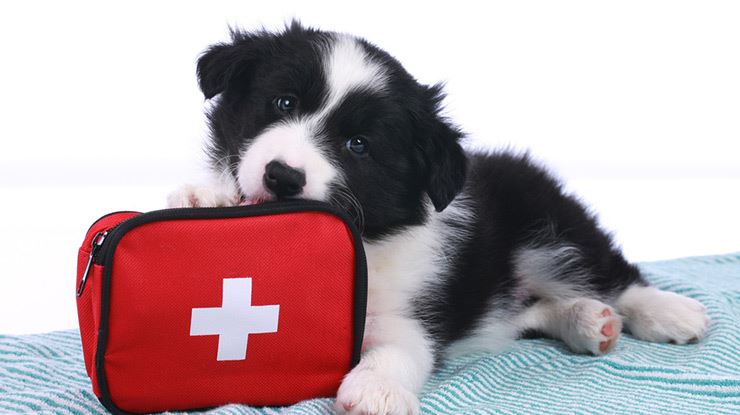
Pet First Aid 101: What to Put in an Emergency Kit
Your dog is both your best friend and your responsibility, which is why you need to make sure that he’s happy and safe. After all, even a young and perfectly healthy dog could get into an accident, which is why you need to plan ahead before problems arise. This is why a small emergency kit is a great idea—it can help you address many medical issues on the spot.
A good pet first-aid kit should feature certain accessories, wound dressing supplies, nutritional support, and medicines your dog may need. The following guide will give you a few essentials that would make excellent additions to your pet first-aid kit.
Books and Documents
Before moving on to medical supplies, make sure that you have books and documents with pertinent information readily available.
A first-aid book for dogs is a good idea. Look for additional texts that refer to the status of your pet: young puppies, pregnant dogs, older dogs, dogs that have chronic medical conditions, etc.
In addition, a few other necessities to keep you prepared include:
- Your vet’s phone number or emergency contact information
- Your pet’s medical paperwork, preferably in a sealed bag
- A poison control center hotline number
- The addresses of the regular vet and the emergency clinic (in case you’re not around and somebody else has to take your pet there)
Pet Accessories and Specific Items
Certain accessories and pet-specific items are also important first-aid kit items.
For example, you need to have a collar and a leash, but you may also want a muzzle to ensure that your dog can’t bite if he gets nervous.
Other tools and supplies may be required to ensure your pet’s hygiene, to extract a foreign object, and to groom and keep your dog feeling cozy during an emergency. The following would make good additions to your dog’s emergency kit:
- Scissors, tweezers, nail clippers
- Syringes
- Clean towels and cotton balls
- A pet blanket
- A pet thermometer
- Disposable latex gloves
- A flashlight
- Splints
Essential Pet Medicines
This category will depend on whether your pet has a specific medical condition. The needs of younger and older pets will also differ.
You may want to talk to your vet in order to determine what medicines you need at home. These are the drugs, solutions, and supplements you can give your pet on your own and without having to consult a professional about the dosage.
A well-stocked first-aid kit will need the following:
- Wound disinfectants to address injuries, bites, and other types of wounds immediately (once the job is done, you’ll need to visit the vet ASAP)
- Antibiotic ointments for eye, ear, and mouth infections, as well as for wounds
- An eye wash solution
- Ear clearing solution
- Activated charcoal—one of the best options to address a poisoning at home
- Anti-diarrheal medicine
- Some common anti-parasitics (make sure these are given to your pet as directed)
- Antifungal ointments, since fungal infections can easily affect the sensitive ears and the skin of canines
- Pain relief medications (please ask your vet which pain relief meds are suitable for your pet and how to administer them at home)
Wound Dressing, Bandages, and Disinfection Supplies
Some of the most common emergencies that pet owners have to address involve wounds and injuries. Treating the wounds of a dog at home may seem daunting at first, but it’s not that difficult. You simply need to have the right supplies available in order to stop the bleeding and disinfect the wound immediately.
Gauze of various sizes, bandages, and first-aid tape are all practical emergency supplies. Human Band-Aids can also be used on smaller cuts and scrapes. Antiseptic wipes are also a good idea, especially when you’re on the go and don’t have access to more sophisticated wound disinfectant options.
Some other wound dressing supplies you may want to add to the first-aid kit include sterile non-stick pads, absorbent pads, strips of clean cloth (which can be used instead of bandages in an emergency), a medication that can be used to stop bleeding (there are medicines out there that induce clotting--ask your vet about them), and tape to secure a bandage in place.
The Next Step
Building a first-aid kit for your dog is a great idea, but there’s more to it than that.
In order to take good care of your favorite fur buddy, you also need some awareness about how to use emergency supplies. Enrolling in a first-aid class will teach you the basics and help you keep the situation under control.
Downloading the American Red Cross Pet First Aid app is another wonderful idea to increase your knowledge and keep yourself from panicking when things don’t go according to plan.
Laura Buckler is a contributor at https://essays.scholaradvisor.com/ and an article writer for various lifestyle magazines. She sees life as an opportunity to play, create and enjoy. She is trying to craft every day according to her vision and to inspire others to do the same. You can follow her on Twitter.










